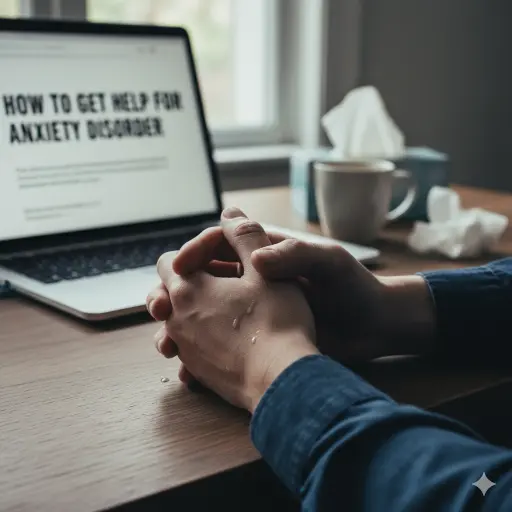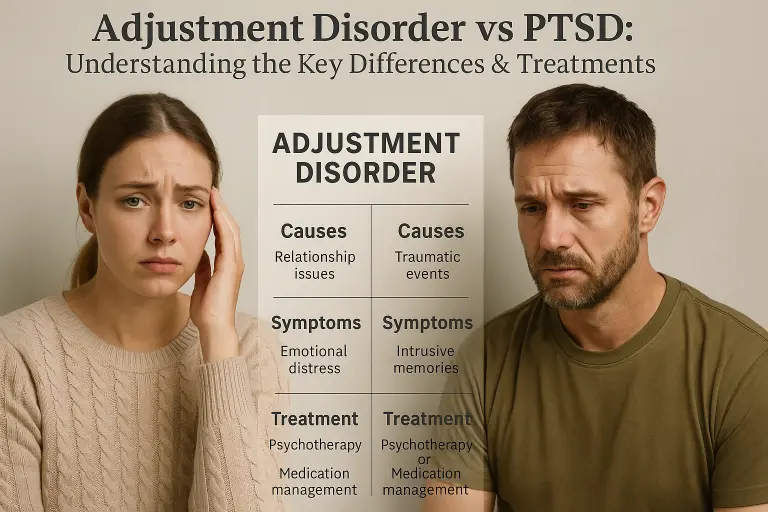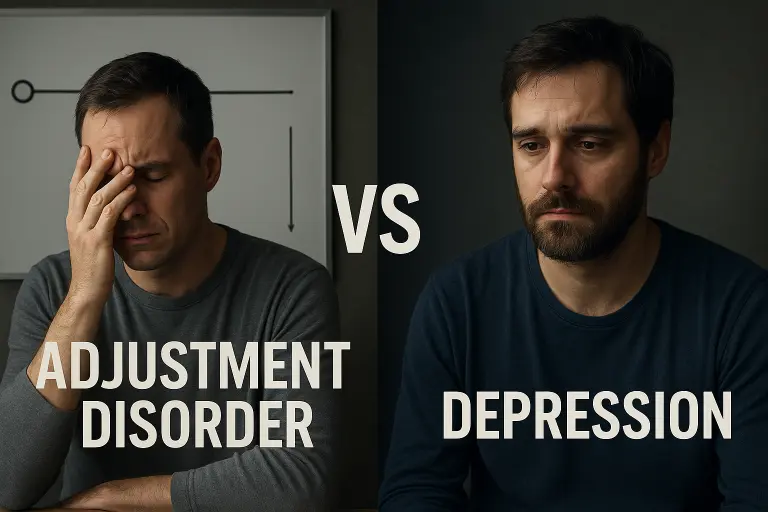Managing Depression and Mania in Mixed Episodes
Explore mixed episodes in mood disorders: when depression and mania coexist. Understand risks and treatments.

Understanding Mood Disorders
Understanding mood disorders is crucial for identifying specific conditions that may affect individuals' mental health. This section explores the diagnostic criteria for mood disorders, specifically focusing on mixed episodes in mood disorders, where depression and mania coexist.

DSM-IV vs. DSM-5 Criteria
The diagnostic criteria for mood disorders have evolved significantly from the DSM-IV to the DSM-5. The DSM-IV required that mood episode symptoms be present for at least seven days to diagnose mixed episodes. In contrast, the DSM-5 has modified this requirement. It mandates that symptoms must be present for a significant portion of the total duration of mood disturbance, allowing for a broader interpretation of what constitutes a mixed episode.
DSM VersionDuration Requirement for Mixed EpisodesDSM-IVSymptoms must be present for at least 7 daysDSM-5Symptoms must be present for a significant portion of the total duration
Prevalence of Bipolar Disorder
Bipolar disorder is a prevalent mood disorder that affects approximately 2.8% of U.S. adults according to the National Institute of Mental Health. The condition is characterized by mood changes that can persist for days or weeks and can range from mild to severe [2]. An important aspect of bipolar disorder is the occurrence of mixed episodes. Studies indicate that around 40% of individuals with bipolar disorder experience mixed episodes, and this figure may be even higher under the DSM-5 criteria, which allow for a diagnosis with fewer symptoms of opposite mood polarity within an affective episode [3].
The prevalence of manic and mixed episodes also relates to the cognitive experiences individuals face. Research shows that those undergoing these episodes may experience racing or crowded thoughts more often. Awareness of these statistics helps in understanding the complexity of managing mixed episodes in mood disorders: when depression and mania coexist.
Mixed Episodes in Bipolar Disorder
Understanding mixed episodes is essential in recognizing how depression and mania can coexist within mood disorders. These episodes bring unique challenges in diagnosis and treatment.
Symptoms and Duration
Mixed episodes in mood disorders involve the simultaneous presence of symptoms from both depression and mania. People experiencing these episodes may exhibit behaviors such as crying uncontrollably while feeling energized or being in a state of euphoria that suddenly shifts to deep sadness. The symptoms can mix in often confusing ways, making it difficult to identify which episode is predominant at any given moment.
According to research, mixed episodes typically last for up to two weeks, although they can sometimes extend beyond this duration. These mixed symptoms tend to be intense and can occur daily, requiring careful monitoring and precise treatment strategies.
Type of EpisodeDurationKey SymptomsMixed EpisodeUp to 2 weeksMania and depression simultaneouslyDepressive EpisodeVariesPersistent sadness, loss of interestManic EpisodeVariesExcessive energy, reduced need for sleep
Risk Factors for Mixed Episodes
Understanding risk factors for mixed episodes can aid in prevention and management. Certain elements increase the likelihood of experiencing mixed episodes in individuals with bipolar disorder. Key risk factors include:
Recognizing these factors is crucial for creating effective support plans. Addressing risk factors can help mitigate the frequency and impact of mixed episodes. For further exploration into mental health challenges, consider reading about the impact of loneliness on mental health.
Impact of Mixed Episodes
Suicidal Risk
Individuals diagnosed with bipolar disorder experience an increased risk of suicide, as they are 10 to 20 times more likely to commit suicide than those without the disorder. This risk escalates during mixed episodes, where symptoms of both mania and depression coexist. Studies indicate that nearly 10% to 15% of individuals with bipolar disorder ultimately lose their lives to suicide. During mixed episodes, the risk of suicide is heightened compared to episodes of bipolar depression alone [4].
The combination of depressive despair with manic impulsivity significantly increases suicidal ideation and behavior. The intensified emotional distress experienced during these episodes underscores the importance of effective treatment and intervention strategies aimed specifically at managing mixed symptoms.
Risk FactorsStandard RiskRisk During Mixed EpisodesGeneral Bipolar Disorder10% - 20%Higher than standardHistory of Suicide AttemptsIncreasedSignificantly increasedComorbid Conditions (e.g., anxiety, substance misuse)HighExacerbates risk
Challenges in Treatment
The management of mixed episodes presents distinct challenges for mental health professionals. Patients often experience repeated episodes of the same nature, exacerbated by greater comorbid conditions such as anxiety spectrum disorders and substance misuse. Rapid cycling, where patients go through various episodes rapidly, further complicates the scenario, negatively influencing prognosis [3].
Effective pharmacological interventions primarily include atypical antipsychotics and mood stabilizers, such as newer anticonvulsants. Combination treatments utilizing two or more medications are common due to the complex nature of symptoms. Notably, traditional treatments, such as lithium for mania, may yield limited effectiveness when both mania and depression are present. Valproic acid (Depakote) is often found to be more effective for managing manic episodes with mixed features.
In circumstances where patients do not respond satisfactorily to pharmacological treatments, electroconvulsive therapy (ECT) emerges as a viable alternative. ECT is noted for its rapid effectiveness and ability to alleviate persistent symptoms, illustrating the severe and challenging nature of managing mixed episodes in bipolar disorder [3].
Understanding the impact of mixed episodes in mood disorders: when depression and mania coexist is crucial for developing comprehensive treatment approaches that prioritize patient safety and well-being.
Bipolar Disorder and Depression
Relationship between Bipolar Disorder and Depression
Bipolar disorder is characterized by the presence of mood swings that include episodes of depression and mania. Individuals can experience mixed episodes in mood disorders, where symptoms of both depression and mania occur simultaneously. This overlapping can complicate the clinical picture, making it challenging to determine the primary mood state. Research indicates that major depressive disorder affects a significant portion of the population, with approximately one in six men and one in four women experiencing it during their lifetimes.
The correlation between bipolar disorder and depression is notable, as individuals with bipolar disorder often experience multiple depressive episodes throughout their lives. The severity of symptoms during the initial depression episode can play a role in predicting future recurrences. Those who experience more severe symptoms are at a higher risk of having subsequent episodes, which can complicate their overall mental health source.
Recurrence of Depression
Recurrence of depression is a prevalent issue among individuals with a history of mood disorders. Studies show that at least 50% of those recovering from their first depressive episode will have additional episodes. Approximately 80% of individuals who have experienced two episodes will encounter another recurrence.
On average, a person with a history of depression may experience between five to nine separate depressive episodes over their lifetime. Factors contributing to recurrence include the presence of comorbid conditions, such as anxiety disorders, substance use disorders, and other affective disorders. These coexisting conditions increase the risk of recurrence and highlight the importance of comprehensive treatment strategies.
Recurrence RiskPercentageOne additional episode after first recovery50%Two or more episodes experiencing further recurrence80%Average number of episodes over a lifetime5-9
The significant impact of recurrent depression includes high suicide rates and impairment in work productivity and social interactions, leading to substantial economic costs. Understanding these dynamics is crucial for managing bipolar disorder and approaching treatment effectively. For more insights into understanding one's mental health, you can explore resources like am I depressed or just sad? or queries such as why am I depressed all of a sudden?.
Treatment Approaches
Managing mixed episodes in mood disorders: when depression and mania coexist requires a comprehensive treatment strategy. Options include pharmacological interventions and, in some cases, electroconvulsive therapy (ECT).
Pharmacological Interventions
In treating mixed episodes, the primary pharmacological agents include mood stabilizers and atypical antipsychotic drugs. Common antidepressants like fluoxetine, paroxetine, and sertraline are not recommended as they may worsen mania symptoms while not necessarily improving depressive symptoms during episodes with mixed features [4].
Medication treatments often involve a combination of two or more drugs to effectively manage symptoms. The following table outlines common treatment options:
Medication TypeSpecific DrugsEffectiveness in Mixed EpisodesMood StabilizersLithium, Valproic Acid (Depakote)Effective for mania, less so for mixed episodesAtypical AntipsychoticsAripiprazole, Olanzapine, Quetiapine, Risperidone, ZiprasidoneEffective in managing manic features
Valproic acid may be more effective than lithium for simultaneous mania and depression [4]. While antipsychotic drugs can be effective for managing mixed features, it's important to have personalized care depending on individual symptom patterns.
Electroconvulsive Therapy
For severe episodes that do not respond satisfactorily to psychopharmacological agents, electroconvulsive therapy (ECT) is an alternative strategy. ECT is often rapidly effective and can lead to the resolution of otherwise intractable symptoms in mixed episodes. ECT may be considered when:
Considering the challenges in managing mixed symptoms, ECT represents a critical and sometimes necessary option in treatment plans for individuals experiencing such episodes. For broader insights into the impacts of mood disorders, check our links on related topics such as understanding the impact of loneliness on mental health and why am I depressed all of a sudden?.
Risk Factors for Recurrent Depression
Understanding the risk factors for recurrent depression is crucial for effective management and intervention. Two significant factors include gender and socio-economic status as well as comorbid psychopathology.
Gender and Socio-Economic Status
Studies indicate that gender plays a role in the prevalence and recurrence of depression. Women are statistically more likely to experience depression than men, and they often face recurrent episodes. This higher prevalence is influenced by various factors, including hormonal fluctuations, societal expectations, and potential stressors unique to women.
Socio-economic status also significantly impacts the risk of depression. Individuals from lower socio-economic backgrounds often face increased stress, limited access to mental health care, and fewer resources to cope effectively with their mental health challenges. This can lead to a higher likelihood of recurrence, illustrating the intertwining relationship between economic hardships and mental health.
Comorbid Psychopathology
Comorbid psychopathology significantly increases the risk of recurrent depression. Conditions such as anxiety disorders, substance use disorders, and other affective disorders can complicate the treatment and recovery process for individuals suffering from depression. For instance, individuals with both depression and anxiety are at a markedly higher risk of experiencing recurrent depressive episodes.
The presence of any comorbid non-affective Axis I disorders, particularly affective disorders like dysthymia, has been linked to a higher incidence of recurrent depression. Research shows that the severity of symptoms during the first episode of depression is closely related to the likelihood of future episodes. A more severe symptom presentation often results in a greater risk of subsequent recurrences.
To better understand the complexities surrounding depression, it can be beneficial to explore questions such as am I depressed or just sad?, why am I depressed all of a sudden?, and why am I depressed in the morning?. These inquiries can provide insight into individual experiences with depression and inform discussions on treatment options and support systems.
References
[2]:
[3]:
[4]:
[5]:
More Resources
A team ready to start your journey.
Get in touch — today.
We are a safe space – a haven for exceptional individuals to receive discreet, personalized, in-person treatment and care.
.avif)









